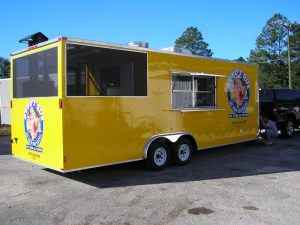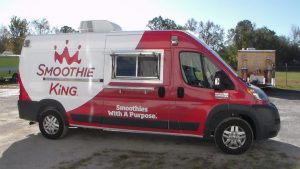Most people recognize that the food truck craze started just right after the economic recession in 2008, but did you know it started way back almost one and a half centuries ago? The idea was conceptualized by Walter Scott in 1872 when he sold pies, sandwiches, and coffee through a “lunch wagon” near a local newspaper office in Providence, Rhode Island. Fast forward to the 21st century, this basic concept has since evolved into a more dynamic way of offering grub to foodies.
Today, the food truck concept brings restaurant-style food closer to consumers. Whether through catering events or while parked along a street in the community, food trucks serve unique food concepts to delight even the pickiest palate. Some people step into the food truck business as a way of introducing their food with the intention of eventually shifting into brick-and-mortar operations. However, the same works with restaurant businesses that use food trucks as an alternative channel to offer their cuisine.
In this article, we take a look at the state of the food truck industry, how it is weathering the current pandemic and its outlook in the near future.

Built by M&R Specialty Trailers and Trucks.
Food Truck Industry Numbers (Updated for 2020)
According to the United Nations’ Food and Agriculture Organization, 2.5 billion people around the world buy food from street kiosks and mobile food outlets every day. (SBDCNet)
30% of food truck revenues come from private events such as birthday parties, weddings, and corporate events. The catering services have helped food truck owners operate all year round. (ACityDiscount.com)
As of 2020, more than 25,000 food trucks are operating across the country, with staggering combined market size of $1.1 billion. (JWU Online)
The overall U.S. mobile food industry generates annual revenue of around $3 billion consisting of about 5,500 businesses (single-location companies as well as branches of multi-location companies). (SBDCNet)
Consumer Demographics
- 54% of diners between the ages of 35 and 44 would eat from a food truck.
- Age segmentation among food truck patrons includes consumers aged 25 to 44 years old (43.4%), those under the age of 25 years old (19.7%), consumers aged 55 years old and above (19.2%), and consumers aged 45 to 54 years old (17.7%). (SBDCNet)
- Diners aged 18 and 34 years old are most probable to grab food from food trucks. (Concession Nation)
- 53% of elder consumers tend to visit a food truck when it is related to their beloved restaurant compared to younger ones. (Concession Nation)
The growth rate of the food truck industry was at 7.3% back in 2017. However, due to stricter city regulations and heightened competition, the growth rate is expected to plateau at 3% through 2022. (ACityDiscount.com)
Food Truckin’ In the USA

Built by M&R Specialty Trailers and Trucks.
In 2020, the U.S. food truck market size is worth $1.1 billion. (IBISWorld)
There are 28,916 employees working in the U.S. food truck industry for 2020. (2nd Kitchen)
The annualized market size growth of food trucks in the U.S. from 2015 through 2020 was pegged at 4.1%. (IBISWorld)
More than 90% of food truck patrons classify their quality of experience as either good or excellent. (2nd Kitchen)
This year, the market size growth rate of food trucks in the U.S. is marked by 0.5%. (IBISWorld)
A food truck’s typical income can reach by as much as $290,000. (2nd Kitchen)
Covid-19 And The Food Truck Industry
- Since the restaurant industry is severely affected by the current health crisis, some restaurant owners are turning into mobile dining to weather the prevailing crisis. (Business Insider)
- The restaurant industry experienced a $25 billion loss in revenue in the first 22 days of March alone. This number ballooned to $80 billion by April, though restaurant owners are bridging the gap between them and their customers by turning to food trucks. (Business Insider)
- More than 50% of revenues come from order-ahead sales in certain cases. The fusion of mobile dining and order-ahead recreate the food experience, especially in these trying times. (Business Insider)
Food Truck Operations
The top 5 best cities to operate a food truck: (Off the Grid)
- Portland
- Denver
- Orlando
- Philadelphia
- Indianapolis
Normally, you would shell out figures of between $28,000 and $114,000 to put up and run a food truck, earning an average of $300,000 annually.
According to the Food Truck Association of Georgia, it takes an average of $100,000 to put up a food truck.
Food truck personnel work an average of 12 to 16 hours per day. (Off the Grid)
The average salary of a food truck owner is said to around $5,000 to $20,000 a month. (FoodTruckEmpire.com)
A food truck can cost you around $50,000, however, newer food trucks can set you back steeply, notably those fully-equipped and lavishly designed.
Generally, mobile food businesses are mandated to go through 45 state/county exclusive procedures to be able to operate. (Off the Grid)
According to a survey conducted by FoodTruckEmpire.com, 85% of full-time food trucks generate over $100,000 in annual gross revenue. (FoodTruckEmpire.com)
A food truck manager’s average salary is approximately $12.11 per hour. (Card Connect)
Strategies And Trends

Built by M&R Specialty Trailers and Trucks.
Biodegradable Packaging. Environment consciousness is bringing biodegradable packaging into the talking point on the future of food trucks. Given the grab and go culture of food trucks, some event organizers are now mandating food truck owners to shift to biodegradable packaging. In the U.K., there’s even talk of taxing single-use plastics to address environmental concerns. (Street Food Central)
Variety. Just like Brick-and-mortar restaurants, each place offering a unique and distinct cuisine. Offering a wide variety of food choices, beyond the common pizza, burger, and taco truck means there’s food for each and every one. (Food Well Said)
Going Vegan. The vegan movement has made its presence felt, and it will continue in the years ahead as people shift to a healthier lifestyle. In the next 4 years, the U.K. vegan alternative market is set to expand by 25%, while the U.S. has seen a growth of 600% of individuals classifying themselves as a vegan in the past 4 years. (Street Food Central)
Some Ideas To Boost Your Food Truck’s Revenue
- Offer Something That’s Not There Yet. We already know how crowded the food truck industry is. Though popular, most food trucks offer the same grubs: burgers, tacos, pizzas, etc. The idea here is not just to stand out, but to offer something that no other food trucks offer yet. Do some market research, look at the local food cart’s menus, and determine what’s missing. Offering global cuisines is a good idea as well.
- Create A Unique Concept. This is where you initially need to stand out. The design, name, and food offerings will help establish your brand. It’s like calling people to check you out without causing too much disturbance. A catchy name or phrase will almost certainly catch customers’ attention, though make sure that your food lives up to the hype. As the saying goes, “If you build it, they will come.”
- Mobile Ordering and Other Payment Options. This is especially true in these times. The current pandemic has changed the landscape. As cities and governments implement lockdowns and social distancing, offering mobile ordering and cashless payment options can be a game-changer in this industry. As people limit their exposure outside until the current health crisis dissipates, these methods can help your food truck continue generating the sales you need. Linking to third party apps and offering mobile services are some ideas to achieve this strategy.
Personal Connection. Customers nowadays look for a personal connection to what they buy. This is especially true for Millennials, who are passionate about the products and services they buy or experience. Your customers would most certainly want that personal experience when they go to your food truck. These connections may come in your personal interaction towards them or anything that would make their dining experience with you, unique. (Food Well Said)
Digital Presence. Food truckers and other mobile food services like caterers are establishing their own websites. Other than third-party websites that promote mobile food businesses, having a website or social media presence can provide you a digital footprint where people can easily find you. This can somewhat be connected to the previous item, a personal connection which you can share with your customers. (Street Food Central)
Final Thoughts
Despite tightening state guidelines on mobile food businesses, the food truck industry remains strong. Food trucks bridge the food gap between customers and brick-and-mortar places.
The food truck industry will be able to weather the current pandemic as food is essential. Unlike brick-and-mortar restaurants, food truck doesn’t offer an enclosed dining experience either and aren’t locked into to specific locations. The coming years will require continued for food truck vendors, but this is an industry that’s accustomed to and ready to adapt to change.

Leave A Comment